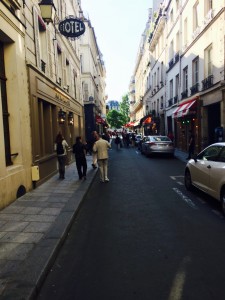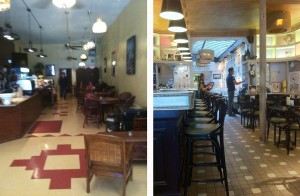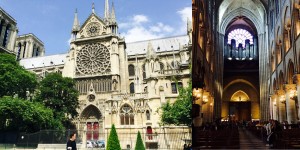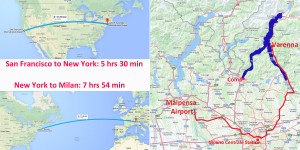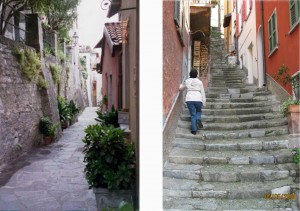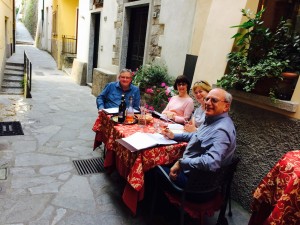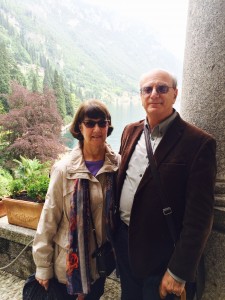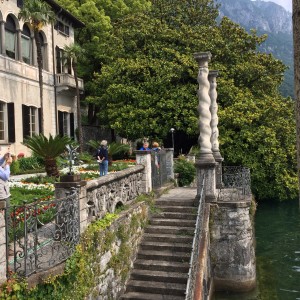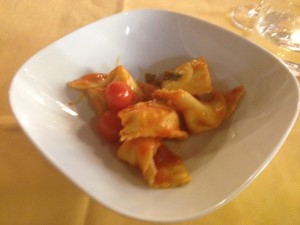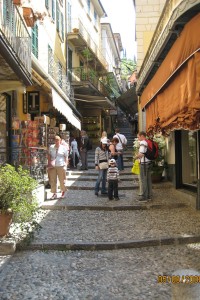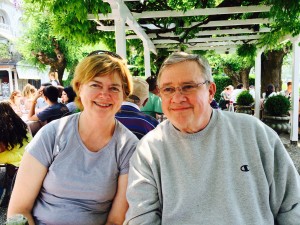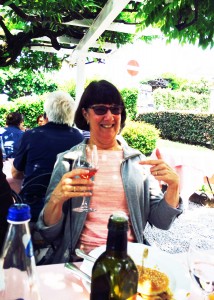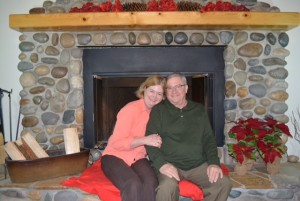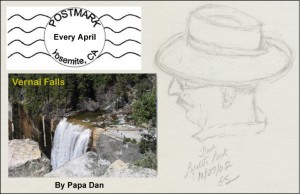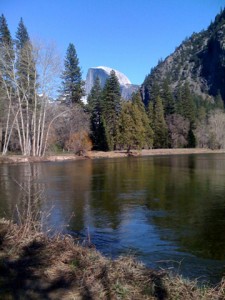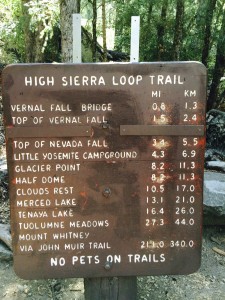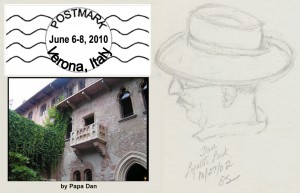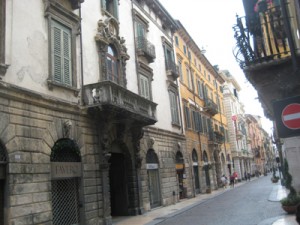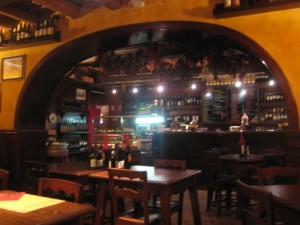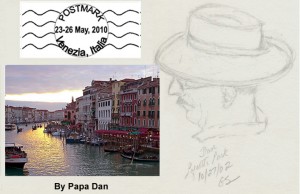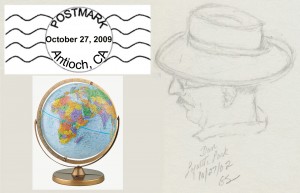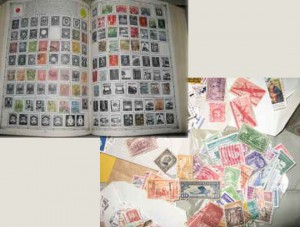Archive for Travel
To Witness the Miracle
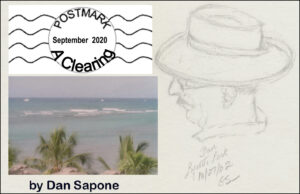
“We are here to witness the miracle.”
— Ray Bradbury
“So, what’s it all about?”
— An American college student in Florence
Since this year, 2020, has not been kind
to travelers (or anyone really); some of us
who have enjoyed the pleasures of travel,
pleasures that have been denied to us
during this COVID year, might want to remind ourselves
of some ideas that emerge from an important question.
= = = = = = = = = = = = = = = = = = = = = = = = = = = = = = = = = = = = = = = = =
Why Travel?
Kappa’a, Kaua’I, Hawaii — A taxi to the BART station, a train to the airport, a series of hurry-up-and-wait movements, and we find ourselves on an airplane, seatbelt buckled, ready to go. Hours later, a smooth landing, more rolling through another airport, a taxi, and a hotel — and here we are! A comfortable place to sit, a glass of wine overlooking the ocean, this was clearly a good idea. No question about it.
We have arrived. Now what? What exactly am I looking at? What should I think about?
— • —
A Clearing
In the 1950s, philosopher Martin Heidegger suggested that, if you can clear away all of the ‘stuff’ that you carry with you that clutters up your life, what emerges from that clearing will help clarify the world around you. He called it (among other things) “truth.” That sounded useful; so, I tried to do that — to make such a clearing — since, here on a beach on an island in the Pacific Ocean, I seemed to be in a place conducive to the making of clearings.
We were sitting at a small patio on the edge of the northern-most Hawaiian island: Kauai. Looking out at that vast ocean, it is easy to let go of things that usually clutter up your mind. The “clearing” that remains offers a lot of room for large ideas to appear, and even a few small ones.
So, what shows up in that clearing?
Surprisingly, the ideas that emerge are not complicated, but simple observations that might be obscured by the details we think about on “normal” days in more familiar places. OK, like what? Well, as I look out to sea, the scene is dominated by one thing: the horizon, just a line, really. I notice that there are no straight lines in this scene, just this one decidedly curved one. No doubt about it, the left and right “ends” of this line that forms the horizon are clearly lower than its midpoint. There can be no question that the complete object, of which this piece of horizon is a part, is not flat.
This observation argues clearly and simply for a round earth. OK, so the earth is round.
That was easy.
Since this “fact” is a relatively new one in human history, I marvel at the power of whatever must have cluttered up the minds of people only five hundred years ago that could have obscured the simple observation that emerges from the clearing I see here. Did nobody notice in all of generations that have walked the earth that the only truly straight lines in existence were man-made? Amazing! And to think that sitting here at the edge of this island made this historic piece of knowledge obvious — a round earth — knowledge that had escaped so many smart people for so long.
Setting aside my amazement for a moment, all the other wonders and beauties we can observe on this island lead eventually to other questions not as easily answered. They are not so much questions about the natural beauty we see around us, but … something else.
OK, so anyone who has tried to ask the “Why?” question knows that it’s never quite that simple. “Why what?” What are you really asking? Why is it round? Why does the water move the way it does? Why does the land occasionally rise above it? The “Why?” questions continue until you stop to consider that there is a question at the root of all of them:
“Why am I here making these observations and asking these questions?”
Of the many humans who have ventured an answer, one writer has held my attention for some time. On the day Neil Armstrong first walked on the moon, science fiction writer Ray Bradbury answered that question for Walter Cronkite: “We are here to witness the miracle,” he said.
–> We are here to witness the miracle. <–
Lots of writers have offered the opposite view that we human beings ARE the miracle — that all of creation has had the primary purpose of bringing human life to this planet. Bradbury’s very different view begs three further questions:
One: If WE are not “the miracle,” then what exactly IS the miracle?
Two: Why does the miracle need a witness?
and, of special interest to artists and writers,
Three: What are the responsibilities of beings created to witness to such a miracle?
While seeking answers to the large questions that emerge from ‘clearings,’ one might ask a smaller one: –> Where does one go to get a closer look at such a miracle?
So, we travel in search of it.
Writers have been telling us that for a long time, and they’ve identified different kinds of miracles. Thornton Wilder has a character who explains that for us in his play Our Town — and she was a character who spent a lifetime without ever leaving Grovers Corners. She observed: “It seems to me that once in your life before you die you ought to go see a country where they don’t talk in English and don’t even want to.” And why is that worth anything? Mark Twain answered this way: “Travel is fatal to prejudice, bigotry, and narrow-mindedness.” And he went on to say, “…nothing so liberalizes a man and expands the kindly instincts that nature put in him as travel and contact with many kinds of people. Broad, wholesome, charitable views of men and things cannot be acquired by vegetating in one little corner of the earth all one’s lifetime.” When faced with a contrary argument, Twain got specific in his book of travel stories, Innocents Abroad: “The gentle reader will never, never know what a consummate ass he can become until he goes abroad. I speak now, of course, in the supposition that the gentle reader has not been abroad, and therefore is not already a consummate ass. If the case be otherwise, I beg his pardon and extend to him the cordial hand of fellowship and call him brother.”
Back to “The Clearing”
If travel is a way of making ‘clearings,’ maybe Heidegger’s “truth” is too large a treasure to expect to find in any single clearing. Maybe the grand moments we expect — like standing before Brunelleschi’s dome in Florence or staring up at the ceiling of the Sistine Chapel in Rome — maybe they are not the most significant of the ‘humanizing’ moments that Twain spoke of. Perhaps more important are the small moments of connection that, when strung together, can add up to ‘truth,’ or some approximation of it. Maybe they can consist of fleeting moments that flash brightly and are then gone. Looking back on our years of travel, some examples emerge.
Humanizing Moments
I recall a weekday night during our first visit to Florence in 2001, we walked around the corner and dropped into a small neighborhood restaurant for dinner – Nello’s. It wasn’t busy, so we struck up a lively conversation with the waiter, who identified himself as “one of the owners.” He answered our touristy questions about Florence and we answered his about San Francisco. We talked about what it was like to live in these two similar places spread so far across the world. He spent a lot of time with us and, near the end of the evening he brought three glassed and we sipped Amarone together for a while before we left. It was delightful. We felt we had made a ‘connection’ with a ‘local’ and it felt good.
When it came time to find a place for dinner on the weekend, we remembered the nice time we had on Tuesday and decided to go back to Nello’s. What the heck, maybe that same guy will be there. That could be fun. So we did.
This time, a Friday night, a tour bus had unloaded and the place was jammed. The same guy was there again, but he was so busy we barely got a glimpse of him. We were lucky to get a table for two in the corner. We greeted him warmly and hoped for a moment of recognition but there was none. Were we ready to order? he asked. I mentioned that Gretta and I had spent the afternoon at Il Academia, which we had talked about with him on Tuesday, but he simply asked, “Some wine?” He took our wine order and left without a nod of recognition. We wondered, had we offended him? What happened to the ‘connection’ we thought we had made? Over the course of the meal, looks passed between us and the waiter indicating that something seemed missing but nothing was said. We decided, he’s just too busy. So, we lingered over dinner and waited until the ‘tourists’ had mostly cleared out. When he noticed that we were still here, he finally came over to us and asked if there would be something more. I tried again to engage him in conversation and commented, “this place is quite different when the tour bus unloads, eh? It was really quiet on Tuesday.” He said, “If you were here on Tuesday, you met my identical twin brother.” He and I looked at each other for a long moment and realized what had been missing. He smiled. “Oh, so we HAVE met. Or so it seemed.”
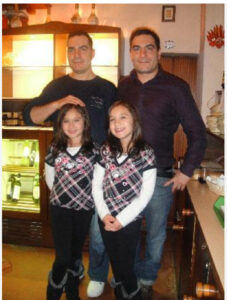
Yes, another connection.
Twin brothers at Nello’s in Florence
Such connections can happen in surprising places. One foggy Spring day, on our last day in London in 2003, we got all dressed up to have “High Tea” at the world-famous Savoy. I wore my best Fedora — a “Sinatra-esque” hat like the one my Father wore when he wanted to look dignified. In the restroom of all places, a distinguished-looking gentleman, dressed in a three-piece suit was standing at attention in his role as the restroom attendant. When he handed me a towel, I asked him with mock gravity, which he seemed to understand, “Tell me, sir, is mine the only Fedora in all of London?”
Yes, sir,” he replied returning my serious expression.
“So, does that mean that all of my efforts to bring Fedoras back into fashion have failed?”
“Yes, sir.”
The momentary grin we exchanged as I tipped my hat to go and dropped a few bills in his jar was worth every bit of the price of afternoon tea at the Savoy.
Finally, on a sunny day in Paris, we were sitting at a shady spot overlooking the Luxembourg Gardens. Gretta was drawing the scene of Parisians enjoying one of their unique spots of civic beauty and I was sitting with my notebook, trying to look like a writer. An older couple walked up and leaned on the stone wall in front of us and we struck up a conversation. They showed an interest in what we were doing — “Gretta paints with watercolors,” I said, stating the obvious.
“And you are a writer?” she asked, pointing at my notebook.
“Oui,” I grinned.
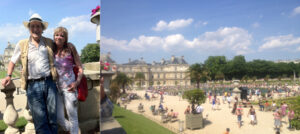
As if in reply, she said, “Let me tell you a story.”
So, sensing an opportunity, I pointed my iPhone and pushed the record button, surreptitiously, I thought. Turns out that they had met as teenagers here in Paris a very long time ago, fell in love, but went the separate ways that life took them — he to the army and she to marriage and children. After many years she returned to Paris — now a widow — and, at the suggestion of her grown son, looked him up on Facebook. And now, here they are, they live in Paris together, where they belong, and were clearly celebrating that fact. As she told her story, the gentleman and I exchanged glances at each other and at my iPhone and he nodded approval. When she was done, I said, “With your permission … “ and I gestured to the iPhone to admit my intrusion. She interrupted me, “Yes, I noticed. It’s a good story, isn’t it? Perhaps you’ll write it down.” We bid each other good day and they were off.
A good story.
The small moments of connection never seem to stop, if you look for them: a woman from the East Bay we met on a boat on Lake Annecy … a bottle of homemade wine gifted to us at the end of a stay at Pomerlo Vecchio in Umbria … an American college student in the Academia in Florence, looking up at Michelangelo’s David, who asked me, “This David is supposed to be a big deal. What’s it all about?”
So, I told him a story that had been told to me — about an inspiring mythical character and a story told in stone by a sculptor more than 500 years ago — “and here we are still looking at it with admiration.” I think he “got it.”
There are many small miracles to witness when clearings are made.
![]()
The Vulcan Salute — Its Time Has Come
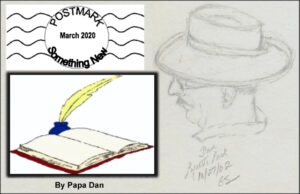
“Live long and prosper.”
“Logic is the beginning of wisdom,
not the end.”
— Mr. Spock
To download a PDF of this post, click here: ConVivio.Vulcan_Salute
===========================================================
The Vulcan Salute

During the days when “Star Trek” was a popular TV show, Mr. Spock (Lieutenant Commander and Science Office of the Starship Enterprise) taught us the Vulcan Salute. In language, it translates to “Live long and prosper.” It was a friendly, respectful greeting that those of us from the 21st century might use in a way similar to our human handshake. So, given today’s reluctance to shake hands for sanitary reasons, it might be used to become a germ-resistant cultural replacement for that time-honored gesture.
Considering the source, Mr. Spock (played by actor Leonard Nimoy) had a dramatic backstory — he had a mixed Human-Vulcan heritage, he taught a number of respectful behaviors to his human colleagues. The character’s father was named Sarek, from the planet Vulcan, and his mother was Amanda Grayson, a human. Due to his mixed-race heritage, the young Spock character had a difficult childhood, bullied on his home planet by full-blooded Vulcan children who made fun of the human emotions he inherited from his human mother. He grew up alongside his half-brother, Sybok, who was eventually cast out for rejecting logic. Although Spock was accepted in the Vulcan Science Academy, he did not enter the academy because they would never fully accept someone who was only half Vulcan. Instead, he succeeded in entering Starfleet, while spending the next 18 years estrange from his Vulcan relatives.
The evolution of the character was interesting in that the network wasn’t pleased with the mixed-race feature of the character and often airbrushed out the pointed ears of the character in promotional photos. After the first season, a rift grew between the show’s creator, Gene Roddenberry, and Nimoy because the writing of the character deteriorated into brief expressions of “fascinating” and “logical”; and more complex interactions of the character with other characters, focusing on his unique racial heritage, were rejected by the network. However, the Vulcan Salute in today’s environment has a number of useful qualities to offer to us 21st-century humans.
Many aspects of Spock’s character endured in popular culture and the boundary between the character and the actor was eventually blurred and then erased. The character was adopted as an informal mascot by NASA and was incorporated into a number of literary successes by authors like Isaac Asimov. An asteroid was named Mr. Spock in 1971 and the character, further promoted by Mr. Nimoy, became an inspiration to a number of scientists and engineers along with a number of more recent honors:
- In 2004, Spock was ranked number 21 in Bravo’s list of The 100 Greatest TV Characters. According to Wlliam Shatner, the other star of the series, “much of the acting praise and media interest in the show went to Nimoy.”
• In 2008, Unified Gamers Online Inc. (UGO) named Spock one of the 50 greatest TV characters for both the original series and subsequent movie appearances.
• In 2012, Imagine Games Network (IGN) ranked the character Spock as the second top character of the Star Trek universe, with Kirk in the top spot.
• In 2016, Adam Nimoy released his very popular documentary film For the Love of Spock, about his father and his iconic character.
• Spock (Nimoy) has been honored by a multitude of film and television institutions for his dominant role among the characters of the Star Trek franchise over fifty years, from the original pilot in 1964 to his final film performance in 2013.
• After the death of Leonard Nimoy in 2015, there has been an increase in the practice of altering the portrait of Canada’s seventh prime minister, Wilfrid Laurier, on Canada’s five-dollar note to look like Spock.
For today, if we all begin promoting the Vulcan Salute as the clinically safe and respectful greeting to replace the handshake, it may actually have a positive impact on reducing the spread of the coronavirus here in the twenty-first century.

Why don’t we give it a try? (Can you do it?)
Finally, at this difficult time in our human history, I am reminded of some words — once used in a movie but originally attributed to John Lennon. He said:
‘“Everything will turn out alright in the end.
If it is not alright, it is not yet the end.”
![]()
Yosemite — October, 2019

“The dry waterfalls and sparse rivers of Autumn simply provide a promise
for the coming of Spring.
The bright Fall colors are a reminder
of that promise.”
— PapaDan
= = = = = = = = = = = = = = = = = = = = = = = = = = = = = = = = = = = = = = = = = =
As I’ve written during previous Autumns in Yosemite, this wonderful valley is always changing. The two most prominent features of Yosemite are “Permanence” and “Change.” (See an old ConVivio piece on that subject.) What’s the Peter Allen song — “Everything old is new again.” Yosemite Valley certainly qualifies as OLD — having been carved by a slow-moving glacier beginning about two million years ago, with its sturdiest rocks (e.g., Half Dome) weighing in geologically at about 87 million years. AND as always, it is NEW again à This year, this month, we observed that the Fall Colors are more dramatic than ever (more on that later).
Another piece of Yosemite news in the “Old-and-New” category is that Yosemite National Park has re-acquired its old revered names — the Hotel is now again named The Ahwahnee and Curry Village and Wawona have their names back, as does Yosemite Lodge, and others. I have known these names for fifty years, and they mean something to me. The lawsuit was settled in July after a three-year fight over ownership of the names.
(Talking with a waiter in the Ahwahnee dining room, I observed that the fight was over money. He corrected me and explained, linguistically, that the problem was caused by ‘politics.’ He said, “ ‘politics’ is a word with two parts: ‘poli,’ meaning many, and “tics,’ meaning small blood-sucking creatures.” I expect to use that line again.)
The Ahwahnee Hotel is certainly old by our own standards, having been built in 1927. BUT, what’s interesting to me is this: the name Ahwahnee was given to this part of the valley by the native Ahwahnichi Tribe about 600 years ago — long before the National Park Service or even the United States of America existed. So, the idea that a 21st-century hospitality management company can claim to “own” that name is ridiculous. But now, sanity has been (temporarily) restored (repurchased) and some good old things are new again.

The National Park Service quickly, proudly, replaced the signs.
Yosemite’s Dramatic Fall Colors — October, 2019
We tend to think of the Stanislaus National Forest, where Yosemite is located, as being dominated by evergreen trees like the Giant Sequoia Redwoods, Ponderosa pines, incense-cedar, Sierra Juniper, white fir, and the like. With that in mind, most of us don’t expect there to be much in the way of dramatic Fall colors. BUT, Yosemite Valley is also populated by California Red Fir, various varieties of Hemlock, California Nutmeg, Black Oak, Alder, Birch, Dogwood, Laurel, Big Leaf Maple, Quaking Aspen, Cottonwood, and Willow. All of these punctuate the broad green background with prominent splashes of reds, yellows, golds, blues, ambers, and combinations of those. Here are just a few examples of photos I took just last week in Yosemite:
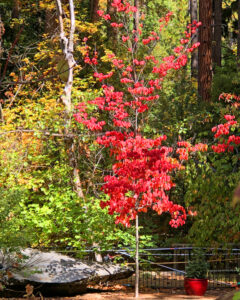
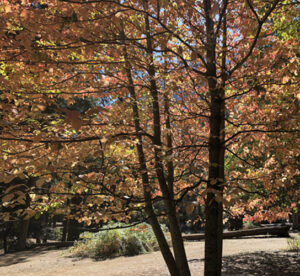
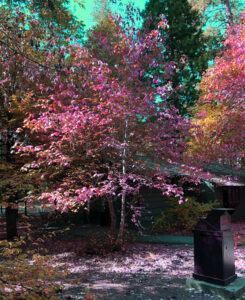
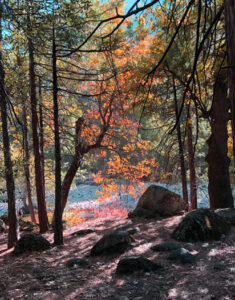
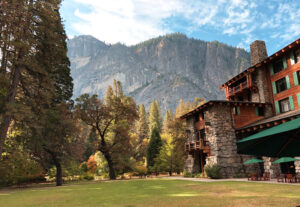
And The Water — October, 2019
As in Autumns past, one of the most striking features of Yosemite in October is:
The silence.
Unless you visit Yosemite in the Fall, when the waterfalls in the valley are dry, you might not realize how much the roar of Yosemite Falls dominates the sound of the valley in the Spring. When the waterfalls are not running, there is a remarkable silence.
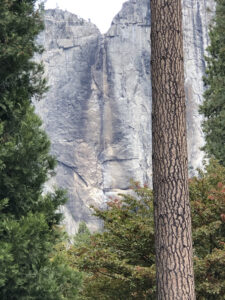
On the left, you can see the place where Yosemite Falls is normally pouring its heart out in the Spring. Here in October — not a drop. The water-scarred granite face of the mountain is bone dry.
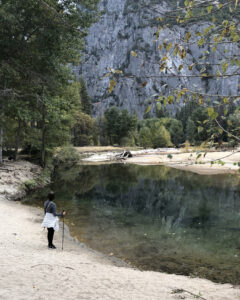
Here, you can see the Merced River where it meanders through the valley. Now, in October, it is lower than I have ever seen it and it’s not moving. In the Spring, on the spot Gretta is standing in this photo, she would be standing waste deep in water. Where I am standing to take this photo, I would be ankle deep. We were told that, even though there was a significantly wet winter this year, more of the precipitation came down in rain and fell later than usual. In fact, you can see the hundreds of fallen trees that were brought down this past winter by the flooding. And, a lot of the snow that had fallen melted quicker than usual between Spring and Fall, causing the waterfalls to dry up sooner and the river to recede more than usual.
Looking Ahead to Spring, 2020
Gretta and I also come to Yosemite every April, for our anniversary, and one thing is a constant in April — Yosemite Falls is always flowing with its usual vigor. The sound is not merely of running water, but of chunks of ice and fragments of logs from the high country crashing down on the rock formations between the peak of the falls and the valley floor. All of that — plus the constant rushing of the water — creates a polyphonic orchestration complete with percussion, and you can hear it everywhere in Yosemite Valley from Half Dome to El Capitan to Glacier Point. We’ll be back in six months to see, and hear, the results that we have come to expect.
The climate is changing. We’ll just have to keep monitoring our best gauge of the changing colors and the water — here in Yosemite Valley. It speaks to us. Our task is to watch and listen.
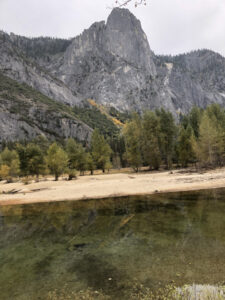
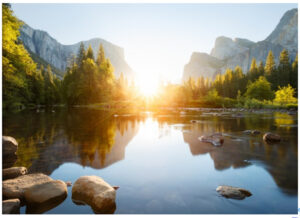
![]()
Yosemite: Change Revisited
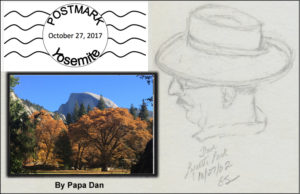
“It is easier to feel than to realize,
or in any way explain, Yosemite’s grandeur.”
— John Muir
“What a treasure to pass on . . .
(but make sure you bring your lunch).”
— PapaDan
Click here to download a PDF of this post:Yosemite, October 17, 2017
= = = = = = = = = = = = = = = = = = = = = = = = = = = = = = = = = = = = = = = =
Yosemite, October 17, 2017
 Sitting here in the middle of a meadow, looking up at Yosemite’s venerable Ahwahnee Hotel, it seems different in some way. Since you probably know some of the history of this place, you may ask with raised eyebrow and derision in your voice “Aw-come-on-now, what could possibly be different?” You might point out a few things like: the iconic stone-and-wood edifice in front of me has looked pretty much the same since it opened in 1927; the granite mountain, El Capitan, to the left of this view has looked much the same for, oh, 50,000 years or so; and the squirrels and blue jays who live here have been scurrying and squawking like this since the glacier melted — so, what could possibly be different?
Sitting here in the middle of a meadow, looking up at Yosemite’s venerable Ahwahnee Hotel, it seems different in some way. Since you probably know some of the history of this place, you may ask with raised eyebrow and derision in your voice “Aw-come-on-now, what could possibly be different?” You might point out a few things like: the iconic stone-and-wood edifice in front of me has looked pretty much the same since it opened in 1927; the granite mountain, El Capitan, to the left of this view has looked much the same for, oh, 50,000 years or so; and the squirrels and blue jays who live here have been scurrying and squawking like this since the glacier melted — so, what could possibly be different?
I’ll have think about it — you’ve asked a big question that demands a big answer; but I, of course, have a small answer:
—> It’s quiet. Nearly silent, actually. THAT’S what’s different.
Gretta and I come to Yosemite every April, for our anniversary, and one thing is a constant — Yosemite Falls is always flowing with its usual vigor. The sound is not merely of running water, but of chunks of ice and fragments of logs from the high country crashing down on the rock formations between the peak of the falls and the valley floor. All of that — plus the constant rushing of the water — creates a polyphonic orchestration complete with percussion, and you can hear it everywhere in Yosemite Valley from Half Dome to El Capitan to Glacier Point.
But, in October (for our second yearly visit), North America’s tallest waterfall is completely dry.
And silent. And, the silence of October is more noticeable than the sound of April. 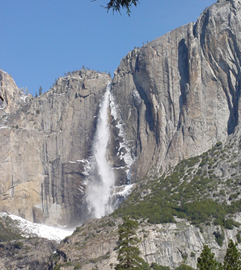
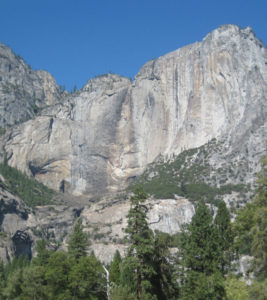
Upper Yosemite Falls (April) Upper Yosemite Falls (October/Dry/Silent)
But, before I claim that everything else around here is permanent, I come to realize that much has changed, and is changing all the time. Some of it matters, and some doesn’t.
The Water
• The water that feeds the Merced River from the opposite side of Yosemite Valley, across from Yosemite Falls (see the images below), originates at the granite dome of Liberty Cap, thunders down at Nevada Falls, sits awhile in the Emerald Pool, rumbles down at Vernal Falls, and ends up meandering through the valley floor in the Merced River. As the seasons change, that river trickles between the boulders at its low point here on October and then swells to a wide, white-water torrent in April. So, at least that much changes; but a wise observer might point out that all of this ebb and flow, the meandering and the raging, the silence and the music of the falls form a never-ending constant cycle in their seemingly eternal alternation between the extremes of life in this valley among these mountains. Yosemite has been here a very long time — longer than the life-span of humans on this planet — and the forces at work here seem to be eternal; BUT those forces are carving a work of art. Each time you look, if you are paying attention, it never looks quite the same as it did the last time you looked.
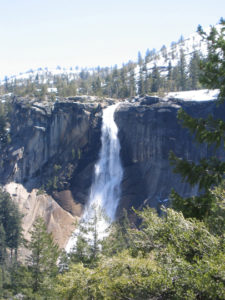

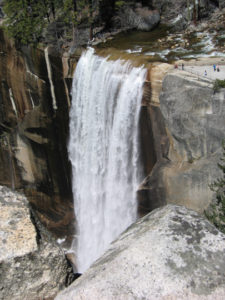
Nevada Falls Top of Vernal Falls/Emerald Pool Vernal Falls
The Granite
• Today, El Capitan slopes at a slightly different angle since last month when a slice of granite the size of an apartment building cracked and crashed down on one of its outcroppings and scattered giant boulders, many the size of automobiles, around its base. Rock falls happen all the time in Yosemite but they are seldom fatal (as this one was) and often not especially noticeable — unless you consider that this entire valley and its surrounding mountains were carved and shaped over thousands of years in precisely this manner. So, Yosemite changes its shape pretty much everywhere you look and pretty much all the time.
The Colors
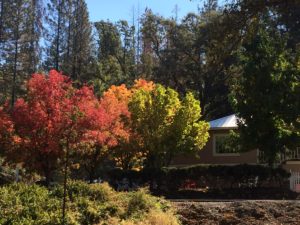
The colors speak for themselves. BUT, some of us have tried to speak for them — and maybe overdone it in the attempt, or not – like our old friend Mark Twain who tries to give us a glimpse, in words, of trees in the fall that change “from green to red, from red to green, and green to gold. The tree becomes a very explosion of dazzling jewels; it stands there, the acme, the climax, the supremest possibility of art or nature, of bewildering, intoxicating, intolerable magnificence. One cannot make the words too strong.” Or so he said.
Twain’s words appeared in the New York Times in 1876, not as evidence of change, but as evidence of permanence — describing something that has been repeated every year since long before humans were here to observe it. And here, now, in Yosemite, we see it once again.
Trivial Change
Now, if we’re going to make a list, some things HAVE changed here in Yosemite, just in the decades we have known it; but those are caused by humans and, therefore, less important:
• The Ahwahnee Hotel has been renamed The Majestic Yosemite Hotel. Why? — because the previous management of the hotel claims to “own” the name “Ahwahnee” after a coupla decades of association with it. The silliness of that view comes to light when you consider that the hotel was named for the Ahwahneechi Tribe who were associated with this part of the valley since about 600 years ago — long before the United States National Park Service granted a contract for restaurants and hotels (OK, long before the United States existed). So, Gretta and I still call it by its rightful name — The Ahwahnee Hotel.
• The Ahwahnee cocktail lounge, which used to serve excellent food all day long, now serves, well … OS (i.e., other stuff). We tried it for breakfast this time … I didn’t know it was possible to screw up yogurt and granola, but now I know. It has been our habit to enjoy a cocktail and tasty appetizers here in the late afternoon. The “cocktail” part endures as it should but the “tasty appetizer” notion is missing. It also used to feature a delightful piano player in the evening (he played everything from classics to smooth jazz to show tunes to classic rock — request almost anything, he knew it). Now the piano is gone to make room for three more tables and a sound system plays, well … OS.
• The Ahwahnee main dining room used to be a 5-star restaurant that attracted outstanding chefs. Now it is just a lovely high-ceilinged, grand building with an OK restaurant surrounded by breath-taking views, pouring from a mediocre wine list, and serving … well, you know, OS. It isn’t even the best restaurant in this valley.
• Oh, and there’s Degnan’s Deli, which used to be an ideal spot to interrupt a day of hiking by ordering a hand-made sandwich, salad, or soup, crafted with fresh ingredients. Now, it is dominated by a display case full of pre-packaged “gas-station-sandwiches.” And they’ve innovated: you can stand in line to order and pay using computerized kiosks and then stand in another line to pick up your order. This “innovation” succeeded in eliminating four employees who used to make your lunch to order from fresh ingredients and take your money at enough cash registers to avoid standing in line. You can still sit at their outdoor stone tables looking up at a stunning view of Glacier Point, but … my recommendation is that you bring your own lunch. Yes, it’s changed.
So, now I’ll stop whining
and tell you why we must continue to return here twice a year.
We come back for the many wonderful things that remain the same here in Yosemite Valley. Here are a few of those in the words of some of our friends:
• Words from Teddy Roosevelt: “There can be nothing in the world more beautiful than the Yosemite … and our people should see to it that [it] is preserved for their children and their children’s children forever, with [its] majestic beauty unmarred.”
• Words from John Muir: “Climb the mountains and get their good tidings, Nature’s peace will flow into you as sunshine flows into trees. The winds will blow their own freshness into you and the storms their energy, while cares will drop off like autumn leaves. As age comes on, one source of enjoyment after another is closed, but nature’s sources never fail.
• John Muir again: “It is easier to feel than to realize, or in any way explain, Yosemite’s grandeur. The magnitudes of the rocks and trees and streams are so delicately harmonized, mostly hidden.”
• Frightening words of warning from NYT columnist Nicholas Kristof: “I can’t help thinking that if the American West were discovered today, the most glorious bits would be sold off to the highest bidder. Yosemite might be nothing but weekend homes for internet tycoons.”
• Words from Robert Redford: “I spent two summers working at Camp Curry and at Yosemite Lodge as a waiter. It gave me a chance to really be there every day – to hike up to Vernal Falls or Nevada Falls. It just took me really deep into it. Yosemite claimed me.”
• Words from Dave Brubeck: “I used to take my mother to Yosemite. When got my driver’s license, that’s where she’d want to go, so I’d go take her there for two weeks.”
• Words from John Garamendi: “Maybe you weren’t born with a silver spoon in your mouth, but like every American, you carry a deed to 635 million acres of public lands. That’s right. Even if you don’t own a house or the latest computer on the market, you own Yosemite, Yellowstone, the Grand Canyon, Golden Gate National Recreation Area, and many other natural treasures.”
• Words from Ansel Adams: “Yosemite Valley, to me, is always a sunrise, a glitter of green and golden wonder in a vast edifice of stone and space.”
• More from John Muir: “During my first years in the Sierra, I was ever calling on everybody within reach to admire them, but I found no one half warm enough until Emerson came. I had read his essays, and felt sure that of all men he would best interpret the sayings of these noble mountains and trees. Nor was my faith weakened when I met him in Yosemite.”
• And, finally, from PapaDan: “Some years, one or more of our sons bring their families up here during the same week we visit, and we have the privilege of taking our grandchildren to the bank of the Merced River (below, left) or up to the base of Yosemite falls (below, right) and watch them enjoy the spectacle in amazement. What a treasure to pass on to the next generation!”
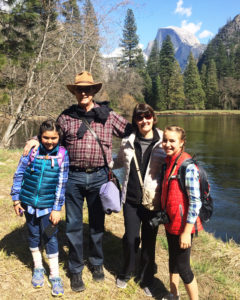

We’ll be back in April!
If you’re interested, click to take a look at a previous post on this topic:
“Of Permanence, Change, and a Sense of Wonder“
Le Flaneur: Getting Lost, Artfully, Passionately, On Purpose
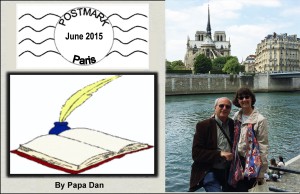 Paris (again and still) — Sitting thirty-some thousand feet above the Atlantic, on our way back from our visit to Varenna, Provence, Paris, and London with a glass of French wine in one hand and a fountain pen in the other, I’m considering what might be worth writing about. As always, one of our goals on this trip was to follow Rick Steves’ advice and become what he calls “a temporary local.” Not sure we did that –it’s hard to do that in a short time. But, I do think we met another goal in the ten days we spent in France: I had hoped once again to imitate one of the most enduring characters of French culture — a character held in admiration for centuries as the personification of all things French. The French have a name for this character: they call him le Flaneur.
Paris (again and still) — Sitting thirty-some thousand feet above the Atlantic, on our way back from our visit to Varenna, Provence, Paris, and London with a glass of French wine in one hand and a fountain pen in the other, I’m considering what might be worth writing about. As always, one of our goals on this trip was to follow Rick Steves’ advice and become what he calls “a temporary local.” Not sure we did that –it’s hard to do that in a short time. But, I do think we met another goal in the ten days we spent in France: I had hoped once again to imitate one of the most enduring characters of French culture — a character held in admiration for centuries as the personification of all things French. The French have a name for this character: they call him le Flaneur.
Le Flaneur has been a literary type since Charlies Baudelaire made this character famous in his poetry in the 1860s. Le Grand Dictionaire Universal in 1872 described Le Flaneur with equal parts curiosity and laziness, an artist-poet of the boulevards, parks, and cafés of Paris; “the closest thing to a sovereign the French should ever have,” he claimed. So, that’s the experience we wanted to have. For at least part of our time in France, I’d like to take a shot at being a Flaneur. So, who is he?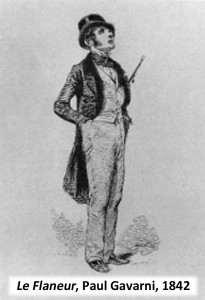
According to a long tradition of French writers, Le Flaneur is the perfect urban spectator, Baudelaire’s “gentleman stroller of the city streets,” engaged in the act of flanerié: aimless strolling, wandering to nowhere in particular, observing everything that presents itself, savoring the multiple flavors of the city. So passionate is his strolling that the act of flané has been described as “the opposite of doing nothing.” In short — it is the act of artfully, passionately getting lost on purpose.
You may ask — what kind of silly goal is that for an American with an Italian name? With all the beautiful and historic sights you can see in Paris, or in the wine-country of southern France, isn’t it sensible to use all of the tools at our disposal to make a schedule, get directions, and make sure we don’t miss a thing in the limited time we have? Well, you’re right – and we’ve done that before. In our first visit to France (Paris and Bourgogne in 2006), we tried to “cover” a lot of the touristy things — le Louvre, le Tour Eifel, le Jardin de Luxembourg, le Museé d’Orsay, Versailles, a boat ride down the Seine . . . But having done that, we set out this time, as we did during our visit to Paris and Giverney in 2012, explicitly to have an experience that doesn’t require (or even allow) a map. So, how does the traveler reconcile the goal of flanerié with the stream of guidebooks and websites full of maps and lists of “must see” things and places, all described with careful instructions on when to go there, how to get there, and what to do when you get there? Well, I’d like to describe a handful of small flanerié experiences we had, quite by accident, during our visits in Paris.
The Madmen of the Island: Le Fous de l’Ille
In 2012, we had the privilege of staying in Paris for nine days. That afforded us the luxury of walking out of our hotel on Rue Saint Louis en I’lle, stopping on the sidewalk, and taking some time to consider the first big decision of the day – should we turn left and cross the bridge toward I’lle de Cité or turn right toward unexplored territory. It seemed kind of obvious that turning left made the most sense. Turning left across the bridge would take us to Notre Dame cathedral. Sometimes there are musicians on the bridge. There is a beautiful park surrounding the cathedral where groups of artists often display their work. Sometimes there are interesting little boats floating down the Seine. And, of course, a couple of doors up from the bridge was the famous ice cream shop le Bertillon – and even though we had just finished breakfast, that would certainly be worthy of my attention.
So, we turned right.
Up the street from our Hotel de la Lutéce, there were a couple of souvenir shops, a French restaurant called Le Med, another hotel, some clothing stores, and some hidden treasures. Even though this is a crowded, narrow street, it hides some cavernous courtyards hidden behind some innocuous doorways –like this one:
[Click to get a look inside (after it loads). Private_entrance]
We may have gotten turned around, so to catch our bearings, we decided to turn left toward the river. (OK, on this little island every direction is ‘toward the river’). So, not having a destination, we drifted past an antique store. It was not especially noteworthy except that it had a graceful little perfume bottle in the window that got Gretta’s attention. Nothing else in the shop seemed particularly remarkable; so we moved on. Another block and we reached the river, turned right (why not?), and wandered past some ordinary-looking buildings. Then it got interesting. We passed a small bistro called Le Fous de L’Ille (translation: the Madmen of the Island). I looked in the window. It looked familiar. To my surprise, the interior layout was the same as the bistro in San Francisco owned by two of our sons – Ben and Will Sapone. It’s called The Flying Pig Bistro, in the Mission District. Very much the same:
- central front door between two large windows,
- alcoves behind the windows with barstools,
- inside, the bar down the left side,
- tables down the right side,
- art and interesting objects on display on the walls,
- kitchen in the back,
- turns out to have a reputation for good food and drink, and friendly service,
- This one has a “rooster” theme, ours back home has a “pig” theme.
Left: Flying Pig, 433 South Van Ness, San Francisco;
Right: Le Fous de L’Ille: 33, rue des Deux-Ponts, Paris
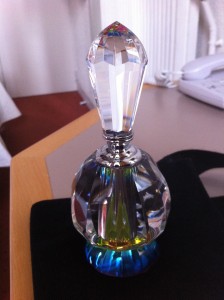 After the amazement wore off, we decided to find our way back to our hotel (or at least to Bertillon’s ice cream store). Gretta said, “What are the chances we could find that antique store? That perfume bottle is calling to me.” So, after a few rights and lefts, we found it and Gretta became the proud owner of a treasure that resides in our home today.
After the amazement wore off, we decided to find our way back to our hotel (or at least to Bertillon’s ice cream store). Gretta said, “What are the chances we could find that antique store? That perfume bottle is calling to me.” So, after a few rights and lefts, we found it and Gretta became the proud owner of a treasure that resides in our home today.
Le Flaneur Goes Left
The next day, walking out of our hotel after breakfast, we confronted the same critical decision – left or right? Today it’s left. Crossing the bridge to I’lle de Cité, there were still no musicians (a story for later). As the windows of Notre Dame cathedral sparkled in the morning sun, Gretta observed “We’ve seen the outside of the cathedral many times, but never the inside. What do you think?” So, we crossed the playground, passed a student group rehearsing a dance performance of some kind, circled around to the front of the church, and stopped at the sight of something we hadn’t quite seen before.
We had seen security guards around major monuments in Europe, but this was different. Three soldiers – not security guards, but fully uniformed, flak-vested, and heavily armed members of the French military – were walking purposefully across the courtyard in front of the church, scrutinizing the hundreds of tourists standing in line to go through the metal detectors. These two held automatic weapons ‘at the ready’ with fingers on the trigger. The third soldier stood at a distance in the same pose, appearing to be watching out for the other two. We had heard that security had been upgraded in Paris since the Charlie Hebdo terrorist attack and other deadly incidents, but for some reason this felt like ‘more’ than I expected. We sat on a bench and watched as two more soldiers turned the corner along the back of the cathedral. “They are serious. This is real.” We talked for a few minutes whether their presence made us feel safer or more at risk. I admit to a bit of sadness at the sight of them. I fully understood and appreciated their presence; but the scene felt more threatening than I had expected. We speculated that this was only the ‘presence’ we could see. There was undoubtedly more that we could not see. We have to arm ourselves this well to feel safe, even here at one of the more serene locations in Europe. Even le Flaneur acknowledges this truth in his observations. After hesitating awhile, we joined the others and entered the cathedral. A beautiful spot, inside and out. Apparently, well protected. Le duex Flaneurs take a taxi – to the Touleries where the afternoon calm and a Provençal Rosé took over.
[Click the link here —> Gretta_cheers_Paris (after it loads)]
Not All Taxis Are Alike
After a glass of rosé and a plate of frites, it’s time to go back “home” to our hotel le la Lutéce. Too far to walk. So the gentleman in the sidewalk, trained to sense when le Flaneur Americane needs a ride, said as we walked by, “Where you headed?”
“Rue de I’lle de Saint Louis,” I said in my best French accent.
“Twenty-five euro.”
After a few seconds of hesitation, he negotiated, “Twenty?”
“Twenty-five if the ride is smooth.” (As you can tell, I’m a tough negotiator.)
[Click on the two links below to take a ride with us – it may take a minute to load.]
A Musician on the Bridge
The bike taxi dropped us off on the Cité side of the bridge. In previous visits to Paris, this bridge had provided a venue for accordion players, saxophone players, trios, and quartets. Today, as we crossed to ‘our’ side of the bridge, we watched two policemen remove a guy who had set up what appeared to be a puppet show on the bridge and gesture to an accordion player that he needed to ‘move along.’ We watched as the policemen walked away, down the street beside the river, and finally out of sight. When they were gone, I greeted the accordion player and gestured toward the policemen and asked “Pourquoi?” “Three time they confiscate my accordion.” He shrugged, looked where they had gone, and brought his instrument into playing position. I handed him ten euro and he began playing. He smiled while he played, but every half-minute or so, he looked over his shoulder, apparently to see if the policemen had returned.
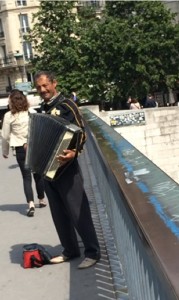 [Click on the link below for a few seconds of his music — it takes a minute to load]
[Click on the link below for a few seconds of his music — it takes a minute to load]
—> Our Musician_on the bridge,_looking
Later that afternoon, we asked why we hadn’t seen many musicians and a waiter at the sidewalk café at ‘our’ end of the bridge he told us “Paris now has laws against asking for money on the bridge.”
Oooooooops.
Finally: Two Lovers In Paris Tell Their Story
One day we wandered to a shady spot overlooking the Jardin de Luxembourg and found a spot with a grand view. Gretta was drawing the scene of Parisians enjoying one of their unique spots of shared public beauty and I was sitting with my notebook and my fountain pen, trying to look like a writer. An older couple walked up and leaned on the stone wall in front of us and we struck up a conversation. They showed an interest in what we were doing. “Gretta paints with watercolors,” I said, stating the obvious.
“And you are a writer?” she asked, pointing at my notebook.
“Oui,” I grinned.
In reply, she said, “Let me tell you a story.” Sensing an opportunity, I pushed the video record button on my iPhone, surreptitiously, I thought.
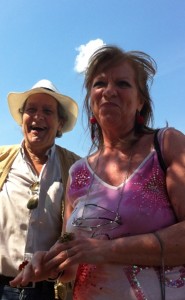 Turns out that they had met a very long time ago as teenagers at a dance, fell in love, but went the two separate ways that life took them — he to the army and a town near Rome, she to marriage and children 600 kilometers away. Decades later, now a widow, she told the story “of my first big love” to her grown son who suggested that she look him up on Facebook. She did. He immediately flew to Italy, and after much back and forth, now, here they are, in Paris together, where they belong. As she told her story, the gentleman and I exchanged glances at each other and at my iPhone and he nodded approval. When she was done, I gestured to the phone and said, “With your permission, I have been …” She interrupted, “Yes, I noticed. It’s a good story. Perhaps you’ll write it down.” We bid each other good day and they were off.
Turns out that they had met a very long time ago as teenagers at a dance, fell in love, but went the two separate ways that life took them — he to the army and a town near Rome, she to marriage and children 600 kilometers away. Decades later, now a widow, she told the story “of my first big love” to her grown son who suggested that she look him up on Facebook. She did. He immediately flew to Italy, and after much back and forth, now, here they are, in Paris together, where they belong. As she told her story, the gentleman and I exchanged glances at each other and at my iPhone and he nodded approval. When she was done, I gestured to the phone and said, “With your permission, I have been …” She interrupted, “Yes, I noticed. It’s a good story. Perhaps you’ll write it down.” We bid each other good day and they were off.
A good story.
[Download and watch Julietta tell her full (5 minute) story, told in her own words at the end of the file below, along with the rest of this post.]
Le_Flaneur_July4_2015_Complete
—–> The flaneur’s lesson:
There are things you will miss if you know where you’re going.
Varenna, 2015: We’re Back — This Time It’s Different
Varenna, Lago di Como, Lombardia, Italia —
 American Airlines brought us to New York, where we stayed overnight. Then — back on the plane to Milan. This is our sixth visit to Varenna, but this time it is different. This time Gretta and I have two old friends with us, Lew and Rita Bell — well, uh, I hope they will pardon the expression “old friends” . . . it’s not that they are old, not exactly, I mean, same age as me, you know, we’ve been friends for a long time, through a lot, you know: Old Friends, right? The point is that on this return to Varenna, they were with us and, borrowing a line from Robert Frost, “that has made all the difference.”
American Airlines brought us to New York, where we stayed overnight. Then — back on the plane to Milan. This is our sixth visit to Varenna, but this time it is different. This time Gretta and I have two old friends with us, Lew and Rita Bell — well, uh, I hope they will pardon the expression “old friends” . . . it’s not that they are old, not exactly, I mean, same age as me, you know, we’ve been friends for a long time, through a lot, you know: Old Friends, right? The point is that on this return to Varenna, they were with us and, borrowing a line from Robert Frost, “that has made all the difference.”
[Click on the image to get better look.]
I met Lew in the dorm at Santa Clara University back before . . . well . . . back before Richard Nixon was elected to a career of making “one thing perfectly clear,” almost a full year before Woodstock and Abbey Road, and before I had any idea what it might mean to have a ‘brother.’ Gretta and I had been telling Lew and Rita about this tiny village we keep visiting on Lake Como in northern Italy since our first visit in 2001. Finally, they decided that they needed to go with us, perhaps to verify that we had not been exaggerating the sweetness of this place (take a look at “The Sweetness of Doing Nothing — Il Dolce Far Niente” at: https://convivio-online.net/?p=271).
So, that was that. They were going with us. We are thrilled that we made it so.
After landing at Malpensa International Airport, we took the usual 63-minute train ride from Milano Centrale train station to Varenna/Esina/Perledo station. That is usually an easy process, but this time Milano Centrale was quite a bit more of a complication than usual. With so many people (millions, they say) in town for the World Expo here in Milan, it took some effort to board the train even with our advance-purchased tickets. But, once we got on board, the view of the Italian countryside along the way was as delightful as ever; so we’re not complaining. Once in Varenna, Albergo Milano, our ‘home’ in Varenna, is only a few minutes from the train station (OK, so is everything else in Varenna) and, as we approached our little ‘street,’ just a narrow stone alleyway (pictured here), everything seems to be just as we left it. The ‘streets’ that are parallel with the lakefront are alleyways like the one on the left. The ‘streets’ perpendicular to the lake are stone stairways, like the one on the right
After a rest, it was time to achieve our first major goal: dinner at Egidio’s La Vista restaurant at our usual dinner table on our own terrace at Albergo Milano. The food and the wine? Well, Egidio’s kitchen is still terrific.
As is typical in this part of Italy, the dinner table is yours all night, so we enjoyed the evening mist, a spectacular sunset, and the sounds of music as the stars came out. Click on the link below for a few seconds of Dinner_at_LaVista. 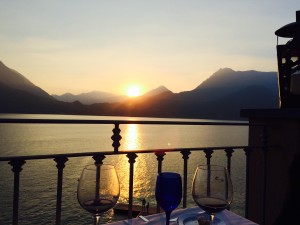
The following night, just about twenty yards down our ‘street,’ we found another sweet dinner table at Borgovino. They put us ‘out in the street,’ eh? (Do I detect a bottle of French Rosé from Provence on the dinner table? Shhhhh!
Villa Monastero
Of the many beautiful places here around what they call ‘mid-lake,’ we also spent an afternoon wandering the length of Villa Monastero, along the southern edge of Varenna. Here are a couple of images (that’s Lew at the top of the ancient stone stairs).
Moreno’s Cooking Class at Il Caminetto
Gretta and Rita spent an afternoon at Moreno’s cooking class up the hill at his restaurant. Il Caminetto is located on a winding one-lane road up the hill behind Varenna. They drive to Varenna’s town square to pick up their guests, because they don’t trust tourists to negotiate this road successfully (once you get on this road you can see why this is a wise decision). Moreno taught them everything one needs to know about tortellini.
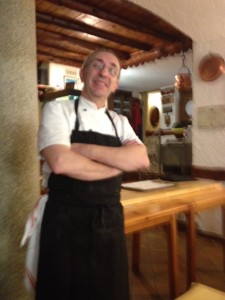 Click to hear a bit of Moreno’s Lesson about the history of Italian noodles (warning: it’s shocking).
Click to hear a bit of Moreno’s Lesson about the history of Italian noodles (warning: it’s shocking).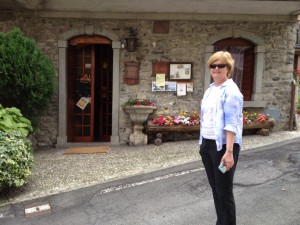
Rita, already a storied chef,
tries her hand at making tortellini.
And click here for a bit of Rita video:
Rita makes tortellini
And the product:
And, of course, Bellagio
The original Bellagio (not the fake one in Las Vegas) — just a fifteen-minute ferry ride across the water.
Lew & Rita (left) at lunch outdoors at Albergo Firenze in Bellagio; Gretta (right) expressing surprise at having wine from southern France (our next stop) here in Italy.
So, after five days, we say goodbye to Varenna and board a high-speed train to Antibes on the French Riviera. Our next installment of ConVivio will come from southern France.
See you there.
![]() Click to download a PDF of this post: Return_to_Varenna_ConVivio
Click to download a PDF of this post: Return_to_Varenna_ConVivio
Yosemite: Of Permanence, Change, and a Sense of Wonder
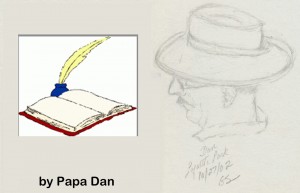 Even (maybe especially) after a few dozen visits to this magical place, a powerful sense of wonder is always present. I am sitting near the back of the Ahwahnee Hotel’s Great Room in Yosemite Valley, accompanied by the family artist (Gretta), a glass of Sonoma County Pinot Noir (from Flowers Winery), and an iPad; my eye drifts up to the gigantic ceiling, built in 1927 and festooned with an Ahwahneechi tapestry, woven deep red, blue, gold, and black, above the six-by-ten-foot fireplace and illuminated by four immense iron candelabra, electrified only in recent decades.
Even (maybe especially) after a few dozen visits to this magical place, a powerful sense of wonder is always present. I am sitting near the back of the Ahwahnee Hotel’s Great Room in Yosemite Valley, accompanied by the family artist (Gretta), a glass of Sonoma County Pinot Noir (from Flowers Winery), and an iPad; my eye drifts up to the gigantic ceiling, built in 1927 and festooned with an Ahwahneechi tapestry, woven deep red, blue, gold, and black, above the six-by-ten-foot fireplace and illuminated by four immense iron candelabra, electrified only in recent decades.
The view from here, positioned behind two thickly covered grand pianos, speaks of enduring elegance, respectfully built on ancient Native American roots, offered here for those who would take their place where presidents, magnates of industry, backpackers, and parents with children on Spring Break have quietly relaxed since before anyone knew there would be either a Great Depression or Great Recession from which to recover. A crew of uniformed servers quietly prepares the afternoon tea-and-cookies service for those who drift in from their day in the woods.
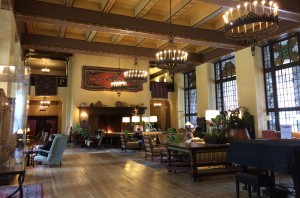 From recent experience, I know that the grandest of the pianos will be uncovered soon, to be employed with the collaboration of Mozart and others to set a mood that alternates between quiet contemplation and festive revelry. Remarkably for those of us mired in the 21st century, the wood-carved sign at the entrance to this Great Room, reminding those who enter to be on their best behavior, is respected and obeyed, evident in the obviously coached youngsters who speak in hushed (for them) tones as they enjoy surroundings that even they know deserve some respect.
From recent experience, I know that the grandest of the pianos will be uncovered soon, to be employed with the collaboration of Mozart and others to set a mood that alternates between quiet contemplation and festive revelry. Remarkably for those of us mired in the 21st century, the wood-carved sign at the entrance to this Great Room, reminding those who enter to be on their best behavior, is respected and obeyed, evident in the obviously coached youngsters who speak in hushed (for them) tones as they enjoy surroundings that even they know deserve some respect.
Today is a surprise. Yosemite has not been immune to the ravages of California’s four-year-and-counting drought, demonstrated by weaker-than-usual waterfalls, above-average temperatures, and NO recent snowfall. But today, April 5th, is different — today we all woke up to falling snowflakes as big as cottonballs and the low temperatures that Yosemite’s regular visitors had come to expect this time of year. So, the snow clothes and smiling faces began gathering in front of the giant fireplace by mid-afternoon.
Precisely at four, a well-dressed gentleman arrives, wheels in his own particular chair, uncovers the piano, becomes comfortable before the keys, and changes entirely the color and flavor of the giant room, using his own particular brand of concentration, without need of sheet music. Activity in the room, however, does not change — gentlemen wearing baseball caps still relax on colorful sofas, dads in snow clothes still wheel baby strollers into the space in front of the fire, accompanied by moms directing toddlers and school kids to their appointed places to divest themselves of wet clothes, carefully hung to dry on the hearth, revealing the activities of the season — gloves and mittens that had been throwing snowballs, stocking hats that had kept ears warm but not dry, boots that had been crunching across the first (and last?) thick snow of Spring, and snow pants that had been crawling on the snow as the older children rolled big balls of ice to create the torsos of snowmen. The music rises to the rafters, not needing volume to command the attention of the room, but not interrupting the business of families doing what they came here to do.
Chopin makes an appearance, again without benefit of sheet music – the gentleman lost in his own enjoyment — not limiting himself to the first movements of pieces most may recognize, but retelling masterworks in their entirety. The room is now filled with the dual majesty of the music inside and the mountains outside. People from multiple generations, classes, and ethnicities read their books, discuss their topics, sip their teas and wines, draw their pictures, and yes, write their words — all under the watchful eyes of Half Dome and Yosemite Falls, peering in through the high windows on opposite sides of this magnificent room.
The multiple personalities of the Spirit of Yosemite make their presence known, even through those high windows — Half Dome, out one window, stands as a dark chocolate truffle, sprinkled with powdered sugar that someone cut in half to see if it’s the one with a raspberry inside. It’s not, but worth the cut to find out. Out the opposite window, Yosemite Falls, diminished in volume by a drought-ish and warm winter, pours its modest goodness into a splash of mist just visible between tall, straight evergreens and bare, spreading oaks.
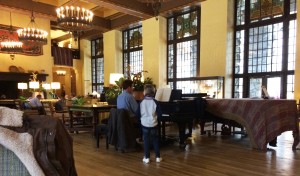 Tchaikovsky appears, as does sheet music for the first time, as a young girl slides up to look over the gentleman’s shoulder at the piano. She steps progressively closer as the music gets more animated, eyes wide, alternately staring at the sheet music and at hands on the keys, all the while bouncing with her hands and arms, revealing some experience of her own at the keyboard. At the end of the piece, he leans back, points at the sheet music, and says to the girl, “Look. It’s not that hard. You could do it.”
Tchaikovsky appears, as does sheet music for the first time, as a young girl slides up to look over the gentleman’s shoulder at the piano. She steps progressively closer as the music gets more animated, eyes wide, alternately staring at the sheet music and at hands on the keys, all the while bouncing with her hands and arms, revealing some experience of her own at the keyboard. At the end of the piece, he leans back, points at the sheet music, and says to the girl, “Look. It’s not that hard. You could do it.”
This is, of course, just a snapshot, a small glimpse in time and space. We can wander from this room to stand before — or even atop — other great natural wonders of our continent: Vernal and Nevada Falls, Mirror Lake, the Merced River, Glacier Point, and rock faces carved by forces we humans cannot duplicate and that we do not live long enough to witness in our collective lifetime on this planet. A snapshot is all we have ever seen; but we continue to imagine the part of the snapshot cropped out of our view, before and after the time and space we occupy.
Why do we come here? Is it for the mountains – appearing larger and more permanent than anything that has surrounded us anywhere else? Or is it the water — to see what it can do when it arrives with power from far above us? Do we come here to be in the presence of creatures — bears and deer, birds and coyote, and their compatriots — not familiar in our neighborhoods back home? Maybe, without realizing, we come to experience the simultaneous work of permanence and change: two illusions who conspire to fool us into thinking we understand the rhythm of this life, only to surprise us by revealing things and ideas hiding in plain sight, that have always been there waiting for us to discover them anew. Are we proud to see that we can erect what we believe to be enduring human elegance, like this grand hotel, amid the seemingly transitory elegance that pours out of the granite for moments and is then gone — over and over, across millions of years that we believe we can count but can really only imagine? Do we come here to listen to the voices that remind us that the things we consider ‘permanent’ are not so permanent to Yosemite — that permanence and change might just be two sides of the same stream? Do we come here to escape the hopelessness we read in the newspaper, which I am reminded to put away when I enter this cathedral of nature? Does our presence here expose a glimmer of hope that parents still bring their children here — as an investment in the future? Perhaps it is that same ever-present sense of wonder, with which I arrived, that brings me back and back again.
Verona — In Search of Montegue, Capulet, and . . . Crollalanza?
Looking for ‘The Bard’ . . . in Italy?!
William Shakespeare is undisputed as the single greatest playwright and poet to write in the English language. From the sheer craft of the poetic use of language and imagery, to the creation of vivid characters for the stage from paupers to kings and everyone in between, to his ability to reveal simultaneously the complexity and simplicity of the human condition, he is the undisputed best the English language and the English-speaking culture has produced. So, why would a longtime student of Shakespeare such as myself, come looking for him here, in an ancient town in northern Italy half way between Milan and Venice? The easy answer is that two of Shakespeare’s most famous and distinct characters, Romeo and Juliet, lived here in Verona during their short lives on the stage at the Globe Theater around the turn of 17th-century in London. Giulietta, in particular, is an important part of the local mythology of this little town. In fact, we learned that people from all over the world still send letters to Giulietta here in Verona.
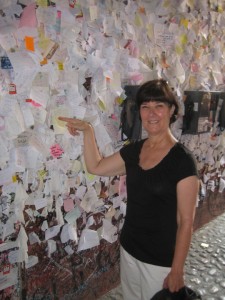
Letters to Giulietta are posted here in the courtyard of 'La Casa de Giulietta' near the Piazza Bra in Verona
How did she and her lover capture the imagination of so many of us?
Romeo Montecchi and Giulia Cappelle were probably real members of two families in Verona who hated each other quite a bit before Shakespeare’s time. A few scholars suggest that Shakespeare may have based his play on a story written by Matteo Bandello around 1550. Whether this story was the source of these actual characters we can only guess; but the Montecchi and Cappeletti families did live here and really did famously feud. Dante, while living in exile in Verona in the early 14th century, actually mentions their names as residents of Purgatorio, presumably as an example of where feuding families end up.
But this speculation does not answer my question, why should we look for Shakespeare himself here in the narrow alleys and ancient piazzas of this little Italian town?
And now for something completely different —
Since the accepted biographical details of the ‘Bard from Stratford’ do not place him anywhere near Verona, a number of questions are unavoidable — Where did this untraveled Englishman get this story? How did he learn so much about Veronese history and culture? Did this man with an undistinguished education write the play at all? Many scholars of this and other plays attributed to Shakespeare suggest other possible playwrights. While I am not going to enter that argument, I am going to start another one — are you ready?
Was Shakespeare Italian?
Over the centuries scholars have been puzzled by Shakespeare’s profound knowledge of things Italian. Shakespeare seemed to have an impressive familiarity with stories by Italian authors such as Giovanni Boccaccio, Matteo Bandello, and Masuccio Salernitano. In an attempt to solve the mystery of Shakespeare’s Italian aptitude, one former teacher of literature has unleashed a new hypothesis on a world eager to hear anything fresh about the Bard.
Retired Sicilian professor Martino Iuvara claims that Shakespeare was, in fact, not English at all, but Italian. His conclusion is drawn from research carried out from 1925 to 1950 by two professors at Palermo University. Iuvara posits that Shakespeare was born not in Stratford in April 1564, as is commonly believed, but actually was born in Messina as Michelangelo Florio Crollalanza. His parents were not John Shakespeare and Mary Arden, but were Giovanni Florio, a doctor, and Guglielma Crollalanza, a Sicilian noblewoman. The family supposedly fled Italy during the Holy Inquisition and moved to London. It was in London that Michelangelo Florio Crollalanza changed his name to its English equivalent. Crollalanza apparently translates literally, from Old Sicilian, as ‘Shakespeare’ (or ‘suddenly shaken or fallen lance’). Iuvara goes on to claim that Shakespeare studied abroad and was educated by Franciscan monks who taught him Latin, Greek, and history. He also claims that while Shakespeare (or young Crollalanza) was traveling through Europe he fell in love with a 16-year-old girl named Giulietta. But sadly, family members opposed the union, and Giulietta committed suicide.
Iuvara’s evidence includes a play written by Michelangelo Florio Crollalanza in the Sicilian dialect. The play’s name is Tanto traffico per Niente, which can be translated into ‘Much Traffic for Nothing‘ or perhaps ‘Much Ado About Nothing.’ He also mentions a book of sayings credited to Michelangelo Florio Crollalanza. Some of the sayings correspond to lines in Hamlet. And, Michelangelo’s father, Giovanni Florio, once owned a home called “Casa Otello”, built by a retired Venetian known as Otello who, in a jealous rage, murdered his wife.
Granted, these similarities between Michelangelo Florio Crollalanza and Shakespeare are intriguing, but for now I remain unconvinced. That Shakespeare was Italian sounds as credible as the idea that Queen Elizabeth I wrote Shakespeare’s works when she was not busy tending to the realm. And I am not alone in my cynicism. While some Shakespearean scholars, most of whom are Italian themselves, are quick to support the hypothesis, the majority are skeptical, to say the least. Although the following excerpt from a biography of Shakespeare by Sir Sidney Lee is not a direct response to Iuvara’s claims, it does illuminate briefly the other side of the argument:
“It is, in fact, unlikely that Shakespeare ever set foot on the Continent of Europe in either a private or a professional capacity. He repeatedly ridicules the craze for foreign travel. To Italy, it is true, and especially to cities of Northern Italy, like Venice, Padua, Verona, Mantua, and Milan, he makes frequent and familiar reference, and he supplied many a realistic portrayal of Italian life and sentiment. But his Italian scenes lack the intimate detail which would attest a first-hand experience of the country. The presence of barges on the waterways of northern Italy was common enough partially to justify the voyage of Valentine by ‘ship’ from Verona to Milan (‘Two Gent.’ I.i.71). But Prospero’s embarkation in ‘The Tempest’ on an ocean ship at the gates of Milan (I.ii.129-144) renders it difficult to assume that the dramatist gathered his Italian knowledge from personal observation. He doubtless owed all to the verbal reports of traveled friends or to books, the contents of which he had a rare power of assimilating and vitalizing.” (Lee 86)
“It was not unusual for an Elizabethan dramatist to set his or her play in Italy. Are we, knowing this, compelled to assume that Marlowe, Bacon, and Jonson were Italian?”
“Admittedly, we do not have much information about Shakespeare’s education, but why is it easier for Iuvara to assume that Shakespeare was an Italian refugee than it is to assume that he mastered Italian culture and history on his own? Jonson’s verses in the Folio identify Shakespeare as the ‘Sweet Swan of Avon’, and his birth record and other important documents attest to the fact that Shakespeare was a resident of England his whole life. Yet some choose to ignore these pieces of evidence in favor of more esoteric theories. One thing is certain – Iuvara’s claim that Shakespeare was Italian will unite Shakespeare supporters and anti-Stratfordians from the camps of Bacon, Essex, Marlowe, Derby, Rutland, Oxford, and Queen Elizabeth in a mutual uproar.”
Further Reading
Lee, Sir Sidney. A Life of William Shakespeare. New York: Dover Publications, 1968.
Based on : Was Shakespeare Italian? Shakespeare Online. 20 Aug. 2000. http://www.shakespeare-online.com/biography/shakespeareitalian
===================
OK, so there you have it — a perfectly ridiculous idea that is the direct result of spending a few days in Verona. It can have that effect on a person. After a few terrific dinners and bottles of local wine in the little restaurants tucked away in the alleys of Verona (two of the best restaurant experiences we’ve had in Italy) and it’s not so difficult to imagine all sorts of stories that put this little town firmly in the center of the universe.
So, why do so many Shakespearean scholars in Britain go to so much effort to refute such an outlandish idea? To use some of the Bard’s own words, “Methinks they dost protest too much.”
Vienna, Austria: City of Musicians
Vienna: Grand, Fun, Musical, and Tasty
I have said many times that my love of travel has most often been focused on small towns and villages — Varenna, with it’s population of 800, first among them — as opposed to the major cities that seem to occupy the most space in travel sections of newspapers and bookstores. But a handful of cities has risen to a short list of ‘favorite’ places we have visited; and Vienna is one of them.
We had the advantage of staying in a lovely suite in a small hotel, Pension Nosek, with two balconies hanging directly over Vienna’s wonderful Graben (pronounced GRAH-ben). The Graben is regularly transformed from a near-deserted pedestrian square to a bustling festival of music, jugglers, mimes, and horse carriages. (Pictures will be added later.) It is a neighborhood that seems to know how to have a good time without being too loud or intimidating.
For the ‘Fashionistas’ among us (and you know who you are), a stroll down the Graben and its side streets provides a window-shoppers paradise with all of the Louis Voiton, Geox, Versace, Cartier, etc, you would find on the Champs Elyses, Rockefeller Center, Florence, or San Francisco. On this street, you can see dozens of:
2,500-euro dresses
700-euro blouses
500-euro purses
400-euro pairs of shoes
to choose from ($1.21 = 1 euro today).
I was delighted each time we walked away from one of these.
Music
Vienna has been known as the city of musicians for hundreds of years and the name still works. Mozart is everywhere — his music as well as Mozart look-alikes selling tickets to tonight’s performance.
Before we left home, we did something we recommend — ordered tickets months ago to a concert at Vienna’s magnificent Musikverein (a photo is in my email). The most beautiful of it’s four concert halls — The Golden Hall — is worth the price of admission just to sit and look up at it for two hours, soaking up its loveliness. When we sat down and said aloud, “This is beautiful!” an older lady sitting behind us at our terrific seats told us, “and it is very old, 1817, and was not destroyed.” In Vienna, which has been in the midst of much modern warfare, the expression “was not destroyed” is used with great feeling. The golden interior design and sparkling chandeliers are breathtaking.
As for the music, I ordered our tickets based on the date we would be there and a performance of the Vienna Philharmonic in the beautiful Golden Hall. The specific musical program was not my choice. I will say only: the twentieth century produced some brutal music. The pieces we heard successfully conveyed the tension, fear, and unresolved dissonance of war-torn Europe. I am glad we had such beauty to look at during the concert.
Fortunately, the city provided much more listenable music — and for free. At the grand entrance on Vienna’s Hofburg Palace, an orchestra and soprano performed outdoors for a large crowd gathered in front of the palace. Also for free was a Baroque quartet performing in St. Peter’s church just a block off the Graben.
Churches
That brings us to churches; we visited two in Vienna: St. Stephen’s cathedral and St. Peter’s. St. Stephen’s, as we see it today, was built between 1300-1450, when Vienna had a population of only ten thousand. It was part of a campaign to elevate the status of the city by convincing Rome to assign a bishop to it by providing a church grand enough for a bishop. Today it is still oversized for its immediate surroundings — pressed in close on every side by the modern city, so much so that it is impossible to get far enough away to get an unobstructed view (or photo) of it. It is black-stained on the outside and dark on the inside, typical of cathedrals of it’s style and time. A blue-laser projected light show drew the attention of lots of cameras; but I hesitate to speculate on any other purpose for it. It didn’t seem to fit the ambiance of a 500-year-old cathedral.
The other church we visited was St. Peter’s — the one I mentioned with the quartet. It turned out that Friday night was the annual ‘long night of the church’ during which churches all over the city are open all night and some have special events (like the free music we enjoyed). We decided that this church had the most beautiful interior of any we have seen. Gretta’s artistic eye was drawn to the wonderful array of colors and the stunning contrast of the many bright shades of blue and the pervasive gold appointments everywhere. (Pictures to come.)
The Food
Our experience of food on Vienna was a surprise. I will reveal here that the best gelato we have tasted anywhere is NOT in Italy (heresy!). It is in a little shop right here beneath our balcony on the Graben. Zanzoni & Zanzoni is run by an Italian couple — the best gelato anywhere.
My second embarrassing revelation is that the best lasagna I have eaten anywhere is also here on the Graben at The Europa Cafe. No foolin’. Light, soft noodles and a deep, rich Southey-Italian sauce that stood up to a complex Sicilian Nero d’Avola red wine. And the best Apple Strudel is, well, everywhere; BUT, it is all second to Gretta’s apple pie (but you knew that).
Wine here is sort of random–Pinot from France, Rhinewein from this neighborhood, even a little Proseco from Italy–but we have been going to cafes here in Vienna and not the fancier restaurants that would have greater selection.
Smoking
The ‘cafe life’ on the Graben (lunch and dinner at the Europa Cafe) is delightful except for the smoke. I believe they have a new indoor smoking ban here but that means that the outdoor cafes are the place to go for smokers. Smoking here is not American-style smoking, it appears to be the primary method of conveying one’s personality — like in old movies, with the prolonged inhaling, stylized holding aloft of the cigarette, and the dramatic directional exhaling they seem to relish so much. It probably is not good news that we are getting used to it.
Vienna is fun and friendly; it is grand with a sense of humor; it is musical and brimming with good food. I also observe that Vienna is less expensive than Venice and has more places to sit and enjoy the gelato. Altogether, it turns out to be our favorite city in Europe.
Venice: Music and Gondolas
Venezia, Italia —
Venice is unlike other Italian cities. The ‘center stage’ of Venice — the Piazza della San Marco (St. Mark’s Square) — is a gigantic demonstration of the two powerful historic struggles that set Venice apart from other destinations we have come to know in northern Italy:
1. The cultural arm-wrestling between Western (that is, Italian) culture and Eastern (that is, Byzantine) culture.
2. The thousand-year struggle for power between the Pope in Rome and The Doge (il Ducale) — the elected head of secular government of the Venetian City-State. They had, shall we say, a different view of the source of authority.
Some of the differences between Venice and other Italian destinations that emanate from these two historic struggles — some significant, some trivial — show themselves readily in a three-day visit. For example, in places we have visited like Varenna, Florence, Stresa, and other Northern Italian cities, waiters in restaurants actually seem to care about the experience customers are having. We noticed lots of eye contact and recommendations about the pairing of food and wine, willingness to engage in conversation. In Venice, waiters make a show of demonstrating, with body language and facial expressions, that they have other more important things to do elsewhere. I believe the French derivation of the word ‘enui’ applies. Customers are just a temporary interruption in the important work they have to do, whatever that might be. This difference extends to the configuration of public spaces. In Lombardia (which includes the lake region), the Liguria (which includes the Cinque-Terre), Tuscany, and Umbria, you can tell the locals are proud of their localities and want others to enjoy them. In our experience, there is always an abundance of places to sit everywhere there is something beautiful to look at (ok, everywhere). In Venice there are essentially two places to sit:
1. The seats at the outdoor cafes all around the piazza della San Marco, where you must order food and drink and pay a six-euro per person cover charge to sit down
2. One marble bench facing the basilica del San Marco in front of the bell tower — seats for about thirty people, always full 24/7, and hundreds of people standing around lusting after these few places to sit, so forget about them.
So Venice, in general, is for standing, unless you are sitting in a gondola, which you must do at least once.
OK, so that brings me to the wonderful things about Venice:
1. The gondola ride through the small canals is a sweet experience. Our gondoliere told us his family has been piloting gondola in Venice since 1740 and told us the entire history of Venice during our one-hour ride. The ride cost 65 euro — the deal I got after walking away from his first offer of 95 euros. We enjoyed his storytelling.
2. Those same cafe tables I complained about as the only places to sit are wonderful, if you DO want to order food and drink. And one more thing — the piazza has three five-piece bands that take turns playing classical, jazz, Italian, Brazilian, French, and American standards, beautifully and playfully done! Each band has the same configuration (must be Union rules?): a female piano player, a man playing a standing base, a male flute player, a female violinist, and a crusty old guy playing a ‘Faletti-style’ accordion. Always. In three days we saw ten different bands in the piazza, each with different people in this same arrangement, all very good. We enjoyed sitting here for five meals in three days.
3. We attended a concert in a small venue where Vivaldi once worked. The five-piece orchestra filled the room with wonderful sound and the soprano and tenor sang truly magnificent well-known arias and duets from Italian Opera. The duets, Donizetti’s ‘Una parola o Adina‘ from ‘L’Elisir D’Amore‘ and Verdi’s ‘Bindisi‘ from ‘La Traviata‘ were wonderfully sung and acted with all of the personality you would expect from the fully staged operas. Of course, Puccini’s ‘Nessun Dorma‘ from ‘Turnadout‘ was overpowering, as it should be.
So, for the traveler, come to Venice to ride the gondola with your sweetie and for the music–both casual and formal. For the historian in each of us, I offer two observations that highlight some significant examples of the way the history of Venice contributed to additional differences between Venice and other Italian locations.
1. All Italian cities and towns are designed around a church or (in the case of cities important enough to have had a bishop) a cathedral. In other important cities (e.g., Florence, Siena, Assisi, Como) the cathedrals were built between the 12th-15th centuries, illustrating Renaissance shapes, styles, and sensibilities, some with Gothic characteristics, but all what we have come to know as ‘European’ influences. In Venice, the cathedral and its many churches, most built in the 10th-12th centuries, have distinct Byzantine influences. Compare, for example, the shapes of the domes and you will find those in Venice to more closely resemble the shapes found in minarets and mosques.
These differences are not just stylistic. When Venice was one of the most powerful City-States in the world, it got that way by dominating the trade routes to the Middle East and acquiring it’s vast wealth from selling eastern spices (most profitably, pepper, it turns out) to the rest of Europe. Middle Eastern ideas of all kinds permeated the art, architecture, and writing that molded Venice’s particular culture and kept it quite noticeably distinct from the rest of the Italian states.
2. While there were constant struggles for power between the Pope in Rome and the other Italian City-States, the Doge (Il Ducale) in Venice had more success than others at keeping the Pope out of his business. Again, the architecture in St. Mark’s Square illustrates.
The cathedral of San Marco (representing the power and wealth of the Roman Catholic Church) and the Palace of the Doge (representing the power and wealth of the secular government of Venice) stand next to each other connected by an arched breezeway. Above the breezeway, is a very interesting relief sculpture clearly showing the bishop/Pope, with the distinctive hat and robes of a bishop, kneeling before the winged lion that represents The Doge, the elected ruler of Venice. Between them is The Book (scripture). While the bishop is kneeling, the winged lion is standing tall over him and (in a perfect reflection of the attitude of Venetian waiters toward their customers) is LOOKING THE OTHER WAY. The message? The church can kneel all it wants, whether to the scripture or to The Doge, but the Doge merely tolerates its presence and, like the waiters on the piazza, has more important things to do elsewhere. That sums up the relationship between The Pope and The Doge, between the church and the civil authority in Venice, as told to us by our gondoliere, as he skillfully guided his gondola through the canals of Venice.
His family has been piloting gondolas in Venice for 270 years, so he knows.
On the Train Between Varenna and Venice
A Lesson: Always Speak to People Sitting Near You on the Train —
After the train ride from Varenna to Milano Centrale station, we found Carozza Uno de Treno 37 — the first-class car — for the two hour and thirty minute ride to Venice. After settling in, a very pleasant woman sat next to me who spoke fluent English and Italian with a cultured-sounding German accent. After a period of silently looking out window at the round hay bales and red poppies, we initiated the usual ‘where are you from?’ … ‘How long have you been around Como?’ She learned that we were going later in the week to Vienna, Melk, and Salzburg and told us that she was a native Austrian, traveling on business and very much approved of our destination choices. She was especially interested on our plan to take a boat up the Danube from Krems to Melk, and took out her MacBook Air laptop (about 1/4-inch thick), connected wirelessly to the Internet, and showed us pictures of a boatride she recommended starting from Vienna instead of Krems. She also recommended a day trip from Vienna to Bratislava for dinner and the Opera, returning to Vienna the same evening — she showed us the website.
I asked, “What brings you here?” She was on her way back to Innsbruck (Austria) from visits to Madrid and Milan with a group from the university at Innsbruck, working with the European Union Parliament. She handed me her business card. It identified her as follows:
Eva Lichtenberger
Member of the European Parliament
Vice President of The Greens/EPS Group
Next to the EU Parliament logo, the addresses indicated that she had offices in Brussels (Bruxelles) and Strasbourg. It turns out that she represents Austria on the E.U. Parliament, a member of the minority party (“hopefully gaining strength,” she said).
We talked about the difficult challenges the E.U. is facing. A big one, she told us, is Turkey. “There is pressure from the U.S. government to admit Turkey to the E.U. The U.S. has good reasons for that position,” she said, “to keep Turkey aligned with The West and pull them away from forces in their neighborhood that are hostile to Western interests.” On the other hand, “It would cost us a great deal.”
She talked about the struggle to incorporate states that have such a gulf between rich and poor, which is the case on Turkey. “Like Greece,” she said, “which is not a poor country, not like your Louisiana, which is a poor state. Nothing you can do with the currency can bridge a productivity gap.”
She talked about her travels to San Francisco, Mexico, New Orleans, Washington, and elsewhere for E.U. meetings and made the point that the cost of rebuilding poor states (like New Orleans after Katrina) is difficult for even the wealthiest countries, like Germany, France, and the U.S. because they have their own commitments to finance.
She told us that the discussion about admitting Turkey the the E.U. “Is a lot like the discussion you might have about admitting Mexico to the United States.” She said. “Turkey would cost us more than Mexico would cost you.” But still, she said, “the reasons for making Turkey a committed member of The West are world-wide reasons. It will be a difficult decision.”
I told her that there is strong interest in the U.S. for the success of a strong Europe (she knew that) and that there has been much written in the U.S. about the need to follow a monetary union with establishment of a political union. She agreed that was the inevitable direction for Europe, but recognized the fear among strong nations of giving up too much sovereignty.
She got off the train at Verona for her return trip to Innsbruck.
The Lesson: Always initiate conversations with people sitting on the train. You never know who you might meet.
Meanwhile, we wend our way through the wine country on our way to Venice.
![]()
We Return to Italy: Stresa on Lago Maggiore
Stresa, Lago Maggiore, Lombardia, Italia — Our 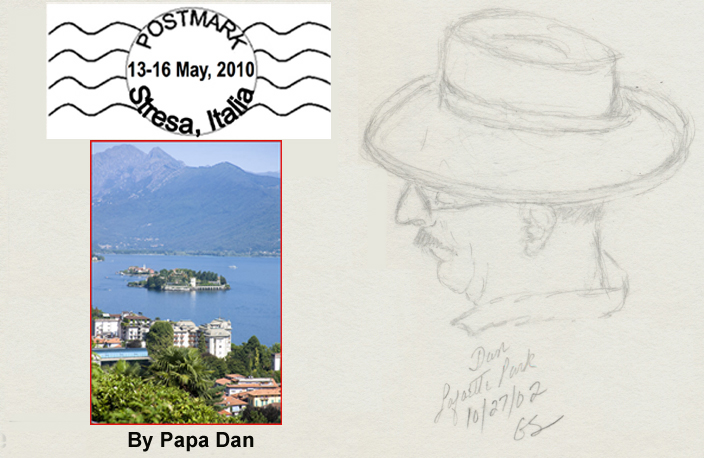 fourth visit to Italy begins here on the edge of Lago Maggiore, “the greater lake,” just west of our old friend, Lago di Como, in the Lombardia region of northern Italy. We’ve learned from experience the advantage of selecting the first place to stay after crossing the Atlantic to be a place to pause and get your bearings in a new country, without having any immediate time pressures and without a lot of stunning places that you ‘must see.’ In our case, we have already spend one night in New York before the longer flight from JFK airport to Malpensa Airport (MXP) in Milano. After our flight arrived nearly on time at 8:30 am, a driver took us by car from Malpensa right to the middle of this lakeside town. The next three days would be for exploring the islands in front of us; but today is for finding some red wine and good food, putting our feet up, and staring at the lake.
fourth visit to Italy begins here on the edge of Lago Maggiore, “the greater lake,” just west of our old friend, Lago di Como, in the Lombardia region of northern Italy. We’ve learned from experience the advantage of selecting the first place to stay after crossing the Atlantic to be a place to pause and get your bearings in a new country, without having any immediate time pressures and without a lot of stunning places that you ‘must see.’ In our case, we have already spend one night in New York before the longer flight from JFK airport to Malpensa Airport (MXP) in Milano. After our flight arrived nearly on time at 8:30 am, a driver took us by car from Malpensa right to the middle of this lakeside town. The next three days would be for exploring the islands in front of us; but today is for finding some red wine and good food, putting our feet up, and staring at the lake.
Crossing the Pond in ‘The Age of the Volcano’
SFO-JFK
So we’ve got this volcano closing airports all over Europe, JFK airport in NYC closed its most heavily used runway for repairs causing delays every day, and, oh yes, tornadoes have sprouted up all over the plains states. So we were having a hard tine expecting a smooth trip. For the past three days we’ve been tracking departure and arrival times, finding flight 16 from SFO to JFK has been running 2.5 hours late all week;. Flight 198, JFK to Malpensa airport in Milan, has been arriving 3.5 hours late this week except for Saturday, when it was canceled altogether. So, as the planner, my mental list of things that could go wrong, and contingency plans, was long.
However, for us, the taxi picked us up at home right on time, got to the terminal in an hour, boarded flight #16, and it departed on time! first lap: check. An hour before landing it was warm chocolate chip cookies and milk. Oh, and one more thing: we landed thirty minutes early.
So much for the hassles of air travel in the age of ‘The Volcano.’ A forty minute taxi ride brought us to Stresa, a beautiful touristy resort on Lago Maggiore.
Stresa and The Borromean Islands
Directly across the lake from our hotel are three islands — The Borromean Islands — that have been owned by the fabulously wealthy Borromeo banking family since Giberto Borromeo ‘The First’ bought the three islands during the first decade of the 16th century.
This purchase completed the Borromeo family’s control of the land all around Lago di Maggiore, known as “The Borromeo State” from the middle of the 15th century. The tremendous power and wealth of the Borromeo family — and its relatives, the Medici of Florence — culminated in the rise in the church of one of their sons, Carlo Borromeo, now know as St. Charles Borromeo. Charles was appointed archbishop of Milan shortly after the death of his uncle Gian Angelo de Medici (also known as Pope Pius IV) in 1565.
After a couple of decades establishing seminaries and defending the church against the Protestant Reformation, Carlo passed away, leaving his cousin Federico to carry on the family’s leadership in the church. Federico promptly mounted a 21st-century-style marketing campaign to get his cousin canonized, which would surely maximize Borromean power throughout Europe.
A contemperary wrote of the campaign: “the tomb of ‘the prince’ was offered as a center of devoted worship. Printed images and paintings of him, edifying tracts, biographies, rumors of miracles and apparitions, and the distribution of relics were not long on spreading his fame beyond the confines of the peninsula as well as recourse to his powers of intercession.” His campaign was successful — Charles was quickly declared a saint on November 1, 1610. As it turned out, the fame that went with the campaign didn’t do cousin Federico any harm either — along the way he got himself appointed to succeed his cousin as Archbishop of Milan and became a Cardinal in 1595, helping the family to consolidate influence and wealth from both sides of the altar. Meanwhile the rest of the family was building the magnificent Borromeo Palace that we visited yesterday — it occupies ALL of Isola Bella across the water from here (on the postcard above). I give them credit — they didn’t just build buildings — they surrounded themselves with well kept natural beauty, plants, art, and exotic animals from all over the world, still in evidence today, right down to the stunning white Chinese peacocks visible all over the island.
A more recent historical note about the palace — in 1935, BenIto Mussolini met in this palace with the leaders of England and France to sign a treaty intended to frighten the Germans sufficiently to deter them from starting World War II. The treaty, displayed on the wall in a room we visited, fizzled when Mussolini went home, allied himself with Hitler, and invaded Ethiopia.
So much for detterence.
Stresa was an excellent choice to get settled after flying across the Atlantic, a place to get over jet lag. It has a spectacular lakefull of historic islands that show off the tremendous opulence of the wealthy and influential families that built Europe on a Rennaisance foundation during the centuries from the 16th through the 19th. For that, we enjoyed our three days here immensely.
We met a French couple — from Alsace — at one of the mediocre restaurants in Stresa. It turns out that they too have returned often to both Varenna on Lago di Como and here at Stresa on Lago Maggiore. After sharing our experiences, the gentleman agreed with my summary: Stresa and Lago Maggiore are beautuful; but Varenna and Lago di Como are magic.
So today the train Is taking us back to Varenna where we will stay at our favorite ‘home’ — Albergo Milano — for seven days. Perhaps we’ll see you there.
The Sweetness of Doing Nothing
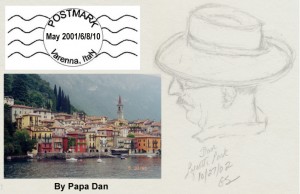
Il Dolce Far Niente
Varenna, Lago di Como, Italia — I am sitting on the terrazzo, watching the ferry boats slide by one at a time across the lake — Lago di Como, a bright blue jewel in Italy’s northern lake region. The sun is trying to get behind the mountain across the lake from us, but finding it slow going. No hurry. There is wine in the bottle. Dinner is in an hour — il dolce far niente, “the sweetness of doing nothing,” is in full flower.
Every quarter hour or so, a large goose on the fishing pier announces the joy of this place in a long, deep honk. No need to disturb the sound of lapping water more often than that. By now, the ferry that launched ten minutes ago from just to the right of my balcony is reaching the point across the lake where a decision must be made: either to put to the right into Menagio, Varenna’s more businesslike twin, or to turn left and wander down the left leg of the lake toward Bellagio, its more famous and fashionable cousin. This one, the Ghisallo, simply makes a wide mid-lake U-turn and returns straight for my balcony before angling back to the dock to my right. Tourists . . .
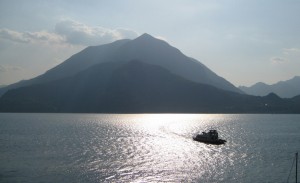 So, how does a day in Varenna begin? After breakfast, when we turn and walk away from this view — back through our bright sunlit room, down spiral stairs, through the colorful lobby, and out into the narrow alleyways that pass for streets here — I find a town interested mostly in itself. While the newspapers are full of national politics, the Italians here have a much more local focus. The headlines describe the impassioned chaos that has caused Italy to elect and dissolve more than fifty governments since WWII; but the local chatter is about the weather and the tourists, the gelato and the children, and who has a new fishing boat. Looking across the red tile rooftops of this town it is easy to see why the 800 people who live here would have a hard time getting serious about the world outside of their colorful self-contained village and its very own slow-paced business.
So, how does a day in Varenna begin? After breakfast, when we turn and walk away from this view — back through our bright sunlit room, down spiral stairs, through the colorful lobby, and out into the narrow alleyways that pass for streets here — I find a town interested mostly in itself. While the newspapers are full of national politics, the Italians here have a much more local focus. The headlines describe the impassioned chaos that has caused Italy to elect and dissolve more than fifty governments since WWII; but the local chatter is about the weather and the tourists, the gelato and the children, and who has a new fishing boat. Looking across the red tile rooftops of this town it is easy to see why the 800 people who live here would have a hard time getting serious about the world outside of their colorful self-contained village and its very own slow-paced business.
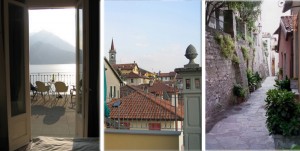
Room #2, red tile roofs, our “street”: XX Settembre
The “business” of the day begins, well . . . late. If a shop posts hours suggesting that it opens at 9:00, you can be fairly sure that it will be ready for you by 9:30. While businesses in America usually post hours like 9:00 – 6:00, or so; here the sign will read something like:
9:00 — 12:00
13:30 — 18:00
The midday break is seldom less than ninety minutes and preparations for midday closing, bringing in the outdoor displays and shuttering the windows, begin around 11:45, shortly after the single gong from San Giorgio’s at 11:30. Sometimes the afternoon doesn’t begin in earnest until 15:00.
So, what do the residents of Varenna do for ninety minutes in the middle of the day? The grocery store is closed. The tabacchi shop, where stamps, newspapers, train tickets, and . . . well . . . tabacchi are sold, is closed. Il pharmacie and il ufficio postale are closed. Il banco, il fiorista, La Villa Monastero — with its beautiful walkways lined with labeled trees and flowers of every color combination — are all closed. Only the pasticceria is open, selling pastries, sandwiches — pannini con formaggio et carne — birra, vino, aqua minerale frizzante, cioccolati, and of course, gelato. So, the logic is clear. At midday, we go to the pasticceria. Until . . .
Seven bells. The announcement comes from the bell tower of the church of San Giorgio, built “probably about 1200” (but first written record of it doesn’t appear until 1313) with four bells, installed in the 17th century, just loud enough to inform this small village that it is time to prepare supper. Click here to see and hear San Giorgio’s bells in action: Bells of San Giorgio — Varenna
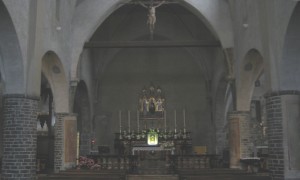 If you happen to walk by San Giorgio’s on your way home and look inside, you will find a simple church, with frescoes of the Holy Family, Saint Christopher, other biblical scenes on the side alters, a small pipe organ, and a very unusual sign, for a church, that greets you in two languages. In English it says:
If you happen to walk by San Giorgio’s on your way home and look inside, you will find a simple church, with frescoes of the Holy Family, Saint Christopher, other biblical scenes on the side alters, a small pipe organ, and a very unusual sign, for a church, that greets you in two languages. In English it says:
“Beauty lives here.
Come in!
But first,
Order your thoughts
And prepare yourself to meet her.”
∞ ∞ ∞ ∞ ∞ ∞ ∞ ∞ ∞ ∞ ∞
As the sun begins to drop behind the mountain, it is time to turn to a more important task: dinner. For a small village, Varenna has a wealth of wonderful food. Most typical is Cavatappi (it means “cork puller”), about twenty yards down our street. It has five tables in a room no larger than my grandmother’s dining room. This is remarkable for a restaurant, considering that in much of Italy, a table belongs to you all evening. So, they serve five magnificent dinners and call it a night. But by far the best food we have tasted in Italy is Egiddio’s cooking right in the restaurant of the small hotel where we have stayed each of our three visits: Albergo Milano. Our favorite table is by far the most beautiful spot to have dinner we have seen anywhere in the world.

Our Table
So, if you’ve observed that not much happened on this day in Varenna, you’d be right. It could be a full-time job if it paid better; but it is not without its compensations. The mind is enriched with simplicity. The eyes are filled with colors, the ears with natural melodies, and the heart with a particular local sweetness. One could do a lot worse than to be a “doer of nothing” in Varenna.
Getting There
• A thirty-minute bus ride from Milan’s Malpensa airport to Milano Centrale train station
• A breathtaking 55-minute train ride from Milano Centrale to tiny Varenna-Esino station (watch for it, the train stops for ONE minute and, depending on how long the train is, you might not see the station when it stops)
• A 5-10-minute walk to any hotel in town.
Staying There:
(We are returning here for the fourth time in 2010)
• Albergo Milano is a dream, with some of the best views and food anywhere.
Bettina & Egidio Mallone
Via XX Settembre 35
23829 Varenna, (LC) Italy
E-mail: [email protected]
http://www.varenna.net
Call from the US: 011-39-0341-830-298
FAX: from the US: 011-39-0341-830-061
Using Varenna as a base of operation:
Look for a future article about the many beautiful places you can visit as day trips from Varenna’s ferry dock: Villa Monastero, Bellaggio, Fiumelatte, Villa Carlotta, Villa Balbianello, George Clooney’s villa in Laglio, the town of Como itself, . . . more.

Varenna’s Ferry Dock & Albergo Oliveda
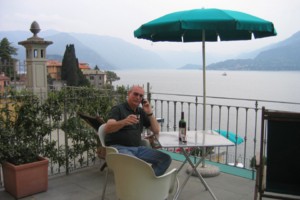
“Buona Sera”
Click here to download a PDF of this article: Varenna_Il_Dolce_Far_Niente
Yosemite — A Place to Stand, A Moment To Savor

Yosemite Valley, California — Thanks to the foresight, eloquence, and hard work of people like The Ahwahneechee, Galen Clarke, and John Muir, the unmatched beauties of this valley can be easily accessible to most of us. But, there are some particularly intriguing views of it that require a bit of struggle. That is fair, of course, given the immense struggle — 20 million years of artful carving by a persistent glacier — that nature endured to form this valley.
On this particular day, Gretta and I are sitting next to a 100-foot tall pine tree in the middle of a meadow about 50 yards from the Ahwahnee Hotel and its five-star dining room. Directly in front of me, Yosemite Falls pours its heart out as it has done since long before human beings stared up in wonder and gave it a name. This magnificent view, one of Yosemite’s most famous, is easy to enjoy — just a three-hour drive from the Bay Area and a five-minute walk from a parking lot to this meadow.
But on Tuesday of this week, we selected a more ambitious project. For decades, I have held a particular admiration for a pair of Yosemite’s less accessible waterfalls — Vernal and Nevada Falls. A pleasant 45-minute walk from the “Happy Isles” bus stop to the wooden bridge across the Merced River allows a hiker to look up at the view of Vernal Falls that Ansel Adams captured in a well-known photograph. That is surely worth the easy hike. But ever since the first time I set foot on that bridge, something has called audibly to me, in a voice from the top of that waterfall. From that first time, it has been clear that the real thrill, and the real achievement, would be to seek out the top of the falls — and a spot from which both Vernal and Nevada Falls are both visible and both audible.
There are two ways to reach the top of the falls from the bridge. One is the direct approach: a sharp left turn after the bridge and a 30-minute climb up what is called the “Mist Trail.” This trail is named for its stairway that climbs alongside the falls — close enough to feel the mist from the falls. This slippery path is most suitable for mountain goats and the most intrepid, sure-footed humans. I took this path years ago when youth and lack of fear gave me confidence that I could reach the top without slipping down the shear rock face to the boulders below. We did not take this path on Tuesday.
The other way is to turn right after the bridge and follow the John Muir Trail on a long winding path around behind the mist trail to the top. We took this path on Tuesday — it is known to be an easier, safer climb.
OK, so let’s define “easier.” For us, this walk entailed four hours of up-and-down switchbacks and narrow ice-filled ledges, some requiring crawling on our hands and knees in the snow.
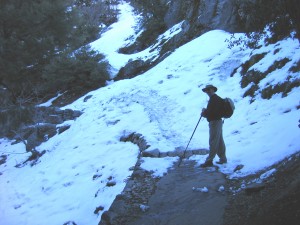
The hike up the mountain was not exhausting, but invigorating, as each turn brought into view a new and spectacular look at the mountain above us and, looking back, an ever-broadening look at the Yosemite Valley we were climbing out of. However, with each passing hour, we reminded ourselves that each step UP the mountain would have to be repeated later on the way down. Our judgment seemed reasonable each time we said, “Well, it would be a shame to come this far without getting to the top.”
So, at long last, one of the turns in the trail rewarded us with the moment we were seeking. Stepping out on a large boulder we looked DOWN at the roaring top of Vernal Falls (as seen in the photo at the top of this essay) and looked UP at its source: gigantic Nevada Falls (below). What a sight! What a place to stand! What a moment to savor!

Nevada Falls
At moments like this, I realize that my most memorable travel experiences have consisted of savoring moments when I have reached a wonderful place to stand — memorable for a range of reasons, from historical significance, to man-made beauty, to sheer natural wonder, like this one. Click here to see and hear a few seconds at the top of Vernal Falls: Top_Vernal_Falls.AVI
The exhilaration of standing on this spot was slowly overcome by a new logic: since it took four hours to get here, it would surely take four more hours to get back. Fear of darkness and the hungry wildlife it would bring out cast a fairly formidable shadow in the bright sunlight of this moment. And, as we began our descent, the aches of already-sore muscles began to make the task ahead seem more and more intimidating with each new switchback and icy ledge. After four hours of uphill and three hours of downhill, the realization emerges that downhill can be much more difficult than uphill for sore muscles and tired feet.
Our twilight arrival at the valley floor was an overpowering mixture of relief and pain. Had this been a good idea? Had we gone too far? I can hear the answer in the voice of the rushing water that called us to that spot above Vernal Falls: “Come and join the beauty, it is worth the struggle.”
It was. ![]()
